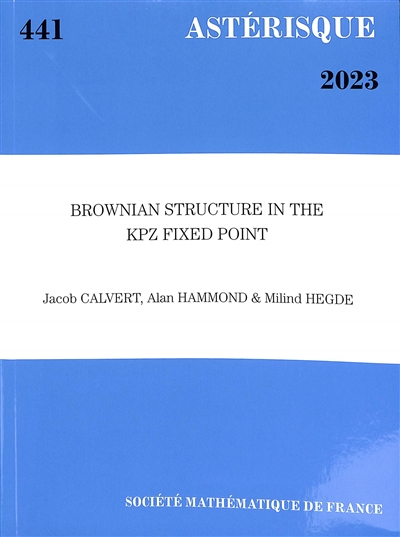Frais de port offerts dès 30 € d’achat (France Métropolitaine)

Frais de port offerts dès 30 € d’achat (France Métropolitaine)
 Panier
0
Panier
0
 Panier
0
Panier
0
 Mon panier (0 )
Mon panier (0 )
Votre panier est vide
























Many models of one-dimensional local random growth are expected to lie in the Kardar-Parisi-Zhang (KPZ) universality class. For such a model, the interface profile at advanced time may be viewed in scaled coordinates specified via characteristic KPZ scaling exponents of one-third and two- thirds. When the long time limit of this scaled interface is taken, it is expected-and proved for a few integrable models-that, up to a parabolic shift, the Airy2 process A : R? R is obtained. This process may be embedded via the Robinson-Schensted-Knuth correspondence as the uppermost curve in an N-indexed system of random continuous curves, the Airy line ensemble.
Among our principal results is the assertion that the Airy2 process enjoys a very strong similarity to Brownian motion B (of rate two) on unit- order intervals. This result yields bounds on the Airy2 probabilities of a large class of events from the counterpart bounds on Brownian motion probabilities. The result has the consequence that the Radon-Nikodym derivative of the law of A on say [-1,1] after a suitable vertical shift, with respect to the law of B on the same interval, lies in every Lp space for p ?(1,8). In fact, the quantitative comparison of probability bounds we prove also holds for the scaled energy profile with Dirac delta initial condition of the model of Brownian last passage percolation, a model that lies in the KPZ universality class and in which the energy of paths in a random Brownian environment is maximized.
Our technique of proof harnesses a probabilistic resampling or Brownian Gibbs property satisfied by the Airy line ensemble after parabolic shift, and this article develops Brownian Gibbs analysis of this ensemble begun in work of Corwin and Hammond (2014) and pursued by Hammond (2019). Our Brownian comparison for scaled interface profiles is an element in the ongoing program of studying KPZ universality via probabilistic and geometric methods of proof, aided by limited but essential use of integrable inputs. Indeed, the comparison result is a useful tool for studying this universality class. We present and prove several applications, concerning for example the structure of near ground states in Brownian last passage percolation, or Brownian structure in scaled interface profiles that arise from the evolution from any element in a very general class of initial data.
Auteur :
Calvert, Jacob
Hammond, Alan
Hegde, Milind
Date de parution : 07/07/2023
Éditeur : Société mathématique de France

(France Métropolitaine)
07400 Le Teil (Ardèche)
Carte bancaire
06 70 63 29 00
check_circle
check_circle
Vous devez être connecté pour enregistrer des produits dans votre liste de souhaits.